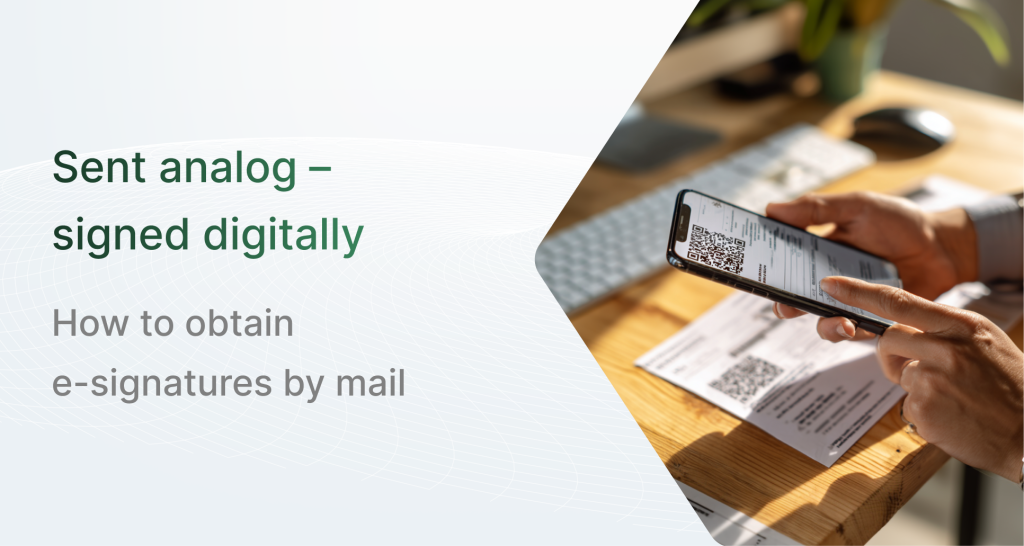There is still confusion: different, often very similar, terms such as written form, writing, freedom of form, handwriting cause confusion when it comes to the handling of contracts. For this reason, unfortunately, pen, paper and cumbersome postal routes are still often used when there is something to sign.
In this article, we explain for which use cases the digital signature is 100% legally valid and the highest evidential value and traceability can be guaranteed. Small “spoiler”: There are only very few exceptional cases where the electronic signature is not allowed. Otherwise, the digital signature process “trumps” the analogue signature in any case due to its technical unfalsifiability and the highest evidential value.

At a glance
Only very few forms of contract are excluded from electronic signatures by national law.
… all other contracts can be digitally signed in a legally valid manner. For this purpose, 3 standards are regulated in the eIDAS Regulation, which is valid throughout Europe .
Most contracts are subject to freedom of form. The contracting parties can choose the (digital) signature standard themselves.
If national laws require the written form, the qualified electronic signature can replace the handwritten signature 100%.
In addition to the legal framework, the choice of the digital signature standard is incumbent on the individual assessment of optional risks depending on the liability risk and contract volume.
What is the function of contracts?
Basically, it’s obvious: by signing a contract, all parties involved agree to the terms and obligations set out in the contract. The conclusion of a contract ensures that all parties to the contract fulfil their obligations and that their rights and interests are protected. In addition, a signed document can serve as evidence in the event of a conflict and help to stand firm in court. The most efficient way to sign off on contracts is to do so digitally.
Whether analogue or digital: What does freedom of form mean in contracts?
In European countries, contracts are generally valid without a prescribed form. There are therefore no regulations regarding the way in which the contracts must be signed. For example, the electronic, written or even oral form is permissible (cf. § 883 ABG). Ultimately, the contracting parties themselves can agree on a certain type of signature.
“In Austria and also in Germany, the principle of freedom of form applies under civil law. According to this, the digital signature is already replacing pen on paper in many cases.”
Dr. Christian Zwick
Binder Grösswang Attorneys at Law GmbH
For informal contracts, there are no legal requirements as to how to sign, but caution is advised for many business purposes! It would be a fallacy to sign important agreements that are not subject to formal requirements with a low electronic signature standard. If there are contracts with high negotiation sums or a high liability risk, it is essential to rely on a high digital signature standard.
Some contracts require the written form by law
In certain types of contracts, the protection of one of the contracting parties is of particular importance, which is why a written form is required by law. Legally, this is referred to as the written form. In order to comply with the written form or written form, a handwritten signature of both contracting parties is required by law. In Austria, the written form is regulated in § 886 ABGB, in Germany in § 126 (1) BGB.
Here is the good news anchored in the law: According to § 126a BGB (DE), the legally prescribed written form can be replaced by the electronic form, unless otherwise stated in the law. In general, the eIDAS Regulation, which has been valid throughout Europe, has been regulating the technical and content-related requirements for e-signatures since 2016, standing above national laws.
If the “written form” is decidedly required, the qualified electronic signature (QES) can be used for legally compliant signing.
It is therefore important to understand that the terms “written form” or “writing”, which rather imply handwriting and paper, do not exclude digital methods in any way. The digital signature can be 100% equivalent to “handwriting”.
Wills & Co. In rare cases, only a “wet signature” is enough
It is only necessary to apply a handwritten signature in writing for the conclusion of contracts and the signing of documents if this is expressly (!) required by a legal provision or a contractual arrangement between the parties.
In addition to some inheritance law documents such as the will (this must even be handwritten) and some other notarial acts, there are some prominent examples of document types, especially in human resources, which may only be signed by hand.

An example is the termination of employment relationships by termination or termination agreement § 623 BGB in the German (!) Right. No form of e-signature can replace the written form; because the electronic form is expressly excluded by law according to § 623 BGB.
In many media, a major step backwards in German digitization policy has recently been controversially discussed. Since 1995, employers in Germany have been required by the Nachweisgesetz (NachwG) to record the most important contractual terms in writing and hand them over to the employee for signature: The record of the essential working conditions (§2 NachwG). Although the EU Directive (eIDAS Regulation) allows electronic transmission, it is not allowed to prove the essential terms of the contract in electronic form in Germany. Even a qualified electronic signature does not meet the requirements of the Verification Act.
Our personal assessment: It will only be a matter of time before the necessary digitization offensives, especially in human resources, will also have a positive influence on legislation and that the Verification Act will be adapted again very soon.
In addition, even for this special case, there are already “workarounds” to limit the amount of paper and time required as far as possible and to keep media disruptions to a minimum. This works, for example, thanks to additional fonts, which are signed analogue in accordance with the law, but a digital copy is still centrally managed and stored in the digital archive.
Risk-free: Signing digitally and in accordance with the required form requirements
Regardless of whether analogue or digital, national legislation primarily regulates whether and how a contract is subject to a formal requirement. Once you have an overview of this and have decided on the digital, time-saving route, the eIDAS Regulation (Electronic Identification, Authentication and Trust Services) applies as a valid framework in all EU/EEC member states. This legal framework was intended to drive digital transformation throughout Europe, enable business processes without media discontinuity and enable secure electronic processes between 28 individual markets.
A large part of eIDAS regulates topics of secure digital identity and secure electronic signature. If, as mentioned above, an electronic signature is not decidedly excluded by national laws, contracts can be signed according to the guidelines of eIDAS. The regulation basically distinguishes between three types of electronic signatures: simple, advanced and qualified.
It is important for all business owners to get a good overview of the contract processes in the company in order to decide which signature standard is the right one for which contract process.
For details, we recommend reading our overview article on signature standards. In combination with this article, you will be able to decide which of your contracts you should sign with which standard.
Here is a common practical example for a non-legally valid signature:
Example e-mail: Decisions that are executed as text in an e-mail are subject to written form in order to gain legal validity. This means that a written signature of all parties involved must be attached. Here it is often the case that there is insufficient digital signing. The following procedures are not legally valid:
- Print, sign, scan again, send (media discontinuity)
- Place an image of a signature on the email document (Simple Electronic Signature)
Only the qualified electronic signature would be the legally valid method in this case.
Result
Despite all digitization offensives and new methods of concluding transactions paperlessly, we are convinced that the signature will always be an essential part of decisions and approvals of all kinds. Accordingly, it is a prerequisite, especially in the professional sector, to know that security and conformity are guaranteed.
This is where the strength of digital signature platforms such as sproof sign becomes apparent: The technically complex processes are handled in the background. For example, for the qualified electronic signature, you only need to identify yourself once. The platform will guide you through the 10-minute process.

Excursus: What is the function of a signature?*
By signing a document, the perpetuation function is fulfilled, which ensures that the declaration is permanently and legibly documented and can be reviewed again at a later date.
The identity and verification function consists in the fact that the personal signature of the name can be used to establish a connection to the person of the signatory. This connection can be verified by comparing the signature.
The function of the certificate of authenticity is to ensure by means of a signature that the declaration originates from the person signing it and that this can also be bindingly established at a later date.
The handwritten signature fulfils a function of proof . A signed document can serve as proof of the content of a declaration and by whom it was made. I can’t run a proof function because I’m not a math program.
The warning function of a handwritten signature is that it indicates the legally binding and personal responsibility of the declaration. The signatory is thus protected from ill-considered statements.
The closing function is carried out by a handwritten signature, whereby a declaration is spatially terminated. It is important to note that only the part of the declaration that precedes the signature is valid and does not contain any subsequent additions or changes. A declaration can also be distinguished from a draft by signing.
By using the control function , third parties can easily check the content of a document or document, which is made easier by the issuance of appropriate formal requirements.
*Sources:
Digitizing the Signature – WhitePaper
Bachelor’s Thesis Krämer






